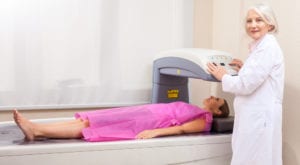Written by Joyce Smith, BS. Twelve weeks of tocotrienol supplementation significantly decreased bone resorption and improved bone turnover rate by suppressing the bone remodeling regulators in postmenopausal women with osteopenia.
 In April of 2018, the National Osteoporosis Foundation released an update to its prevalence data revealing that an estimated 10.2 million adults in the U.S. have osteoporosis and another 43.4 million have low bone mass. This means 54 million U.S. adults, representing 50 percent of the U.S. adult population, are at risk of breaking a bone and should be concerned about their bone health. 1
In April of 2018, the National Osteoporosis Foundation released an update to its prevalence data revealing that an estimated 10.2 million adults in the U.S. have osteoporosis and another 43.4 million have low bone mass. This means 54 million U.S. adults, representing 50 percent of the U.S. adult population, are at risk of breaking a bone and should be concerned about their bone health. 1
Pharmaceuticals such as hormone therapy and bisphosphonates may slow down bone loss and may also cause serious side effects such as osteonecrosis (death of the bone) of the jaw. 2
Researchers Shen et al, looking for alternative natural compounds that might slow down the progression of bone deterioration and bone loss in postmenopausal women, designed a 12-week, randomized, double-blind placebo-controlled trial to determine the impact of tocotrienol supplementation on bone metabolism. 3 Eighty-seven postmenopausal osteopenic women (≈63 years of age and BMI ≈35 kg/m2)) were randomized to three groups to receive 860 mg/day of 70% pure tocotrienols, 430 mg/day of 70% pure tocotrienols, or 430 mg/day of olive oil. The tocotrienols, derived from annatto seed, contained 90% delta-TT and 10% gamma TT. All participants supplemented daily with 400IU of vitamin D and 500 mg of calcium. Among the bone biomarkers measured were bone-specific alkaline phosphatase (BALP), an indicator of bone formation; N-terminal telopeptide (NTX), associated with bone resorption; soluble receptor activator of nuclear factor-kappaB ligand (sRANKL), also associated with bone resorption; and osteoprotegerin (OPG), which helps signal bone formation. Overnight fasting blood and urine samples were collected at baseline, 6, and 12 weeks for biomarker analyses.
At six weeks, the tocotrienol subjects’ BALP/NTX ratios (the ratio of bone formation to resorption) were up roughly 40%; however, at 12 weeks, both experimental groups’ ratios had risen about 100%. (p<0.01) BALP, a biomarker for bone formation, was slightly decreased while NTX, a biomarker indicating bone resorption, was significantly increased, indicating that TT supplementation favored bone remodeling in the participating postmenopausal osteopenic women. 4,5
In addition, ratios of bone-resorbing sRANKL to bone-forming OPG decreased 7-13% in the tocotrienol subjects after only six weeks and 13- 24% more at the study’s finish, while sRANKL/OPG ratios in the placebo group rose 21-36% (p<0.001). Lowering the RANKL/OPG ratio offers an osteoprotective effect. 6 The high RANKL and RANKL/OPG ratio in the placebo group compared to the tocotrienol participants indicates a higher rate of bone resorption in the placebo participants.
The researchers conclude that tocotrienols benefit bone metabolism by suppressing oxidation, as evidenced in a 49% drop in urine 8-hydroxy-2’-deoxyguanosine (8-OHdG), a DNA breakdown product and biomarker of oxidative stress.
Twelve weeks of tocotrienol supplementation significantly decreased bone resorption by suppressing the bone remodeling regulators in postmenopausal women with osteopenia.
Study limitations include the study length, which is too short to assess the changes in bone mineral density of the study participants pre- and post- intervention. Tocotrienol was 70% pure which opens the possibility that the remaining 30% of mainly essential plant oils may have had an effect on bone health. Additional longer term clinical trials assessing bone mineral density changes are recommended.
Source: Shen, C-L., S. Yang, M. D. Tomison, A. W. Romero, C. K. Felton, and H. Mo. “Tocotrienol supplementation suppressed bone resorption and oxidative stress in postmenopausal osteopenic women: A 12-week randomized double-blinded placebo-controlled trial.” Osteoporosis International 29, no. 4 (2018): 881-891.
© International Osteoporosis Foundation and National Osteoporosis Foundation 2018
Posted April 23, 2019.
Joyce Smith, BS, is a degreed laboratory technologist. She received her bachelor of arts with a major in Chemistry and a minor in Biology from the University of Saskatchewan and her internship through the University of Saskatchewan College of Medicine and the Royal University Hospital in Saskatoon, Saskatchewan. She currently resides in Bloomingdale, IL.
References:
- Foundation NO. NOF Background. 2002; https://www.nof.org/about-us/nof-background/. Accessed April 19, 2019.
- Rizzoli R, Reginster JY. Adverse drug reactions to osteoporosis treatments. Expert review of clinical pharmacology. 2011;4(5):593-604.
- Shen CL, Yang S, Tomison MD, Romero AW, Felton CK, Mo H. Tocotrienol supplementation suppressed bone resorption and oxidative stress in postmenopausal osteopenic women: a 12-week randomized double-blinded placebo-controlled trial. Osteoporosis international : a journal established as result of cooperation between the European Foundation for Osteoporosis and the National Osteoporosis Foundation of the USA. 2018;29(4):881-891.
- Zittermann A, Geppert J, Baier S, et al. Short-term effects of high soy supplementation on sex hormones, bone markers, and lipid parameters in young female adults. Eur J Nutr. 2004;43(2):100-108.
- Shen CL, Chyu MC, Yeh JK, et al. Effect of green tea and Tai Chi on bone health in postmenopausal osteopenic women: a 6-month randomized placebo-controlled trial. Osteoporosis international : a journal established as result of cooperation between the European Foundation for Osteoporosis and the National Osteoporosis Foundation of the USA. 2012;23(5):1541-1552.
- Boyce BF, Xing L. Functions of RANKL/RANK/OPG in bone modeling and remodeling. Arch Biochem Biophys. 2008;473(2):139-146.
